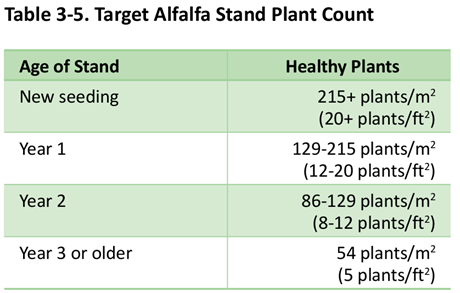Hay Field Spring Stand Assessments
Why?
Weather conditions in the fall, winter and early spring can reduce the productivity of your hay field. It is Important to determine the yield potential of the field and in more difficult cases, the viability.
Questions to as yourself:
- What are your yield targets or expected yield from this field?
- What are your forage production needs?
- Will it lose you money if you keep it?
- Will it be worth harvesting?
- Will it do for another year?
Assess the stand and use the information to make the best management decisions.
The typical lifespan of a healthy stand is 9-12 cuts. If you take 2 cuts a year, it could maintain optimal productivity for up to 6 years. If you take 3-4 cuts a year, it could max out after 3 years. Alfalfa thins out naturally with time. Winterkill happens; there could be heaving or smothering over winter, root rots due to excess moisture. Insect feeding above or below ground can also kill plants. You need to get out there and do some counts.

When?
Once the frost is out of the ground through green up is the optimal window. Ideally you get out there before field work starts and you’re investing money in the field. You could still see loss of plants after this window as well, that’s another reason to assess the roots. Above ground can fool you, a poor root system could support a plant during the early stages of growth, in the spring when there’s more soil moisture, but once the soil dries and plant demands increase, this poor system could lead to plant death. We need to know what portion of plants to expect will die out even after the winter months.
How?
Walk the field in zig-zag pattern, stopping at several locations, making sure to hit the highs and lows of the field and areas of different soil types. 1 count per 15-20 acres, min 2/field.
Assess plant health. Below ground. Dig up a few plants per location and assess root health. What colour is the tissue? Is it white (healthy) or yellow/brown? How does it feel? Strong and firm or soft and stringy? Do they smell like plan rot? What is the proportion of broken/heaved taproots? Unhealthy/rotting roots are not viable. Above ground. Can you see new growth (green tissue)? Is there disease or insect feeding? If so, on how much of the plant and how many plants (disease incidence and severity). It is likely too early to see nutrient deficiencies.
Count the number of healthy crowns/ft2. For stands 6mo-1yr old, 12-20 healthy plants/ft2 will result in good to high yield. Only 12 plants will have reduced stand life, under 12 should be terminated and reseeded. For stands over 1 year old, at least 6 healthy plants/ft2. Less than 6/ft2 you should be adding (more) grasses or terminate the stand. For mixed stands you want the lower end of range, for pure stands, the higher end. Less crowns are tolerable as the stand ages because crowns are larger and produce more stems. You can do stem counts later in season/once alfalfa at least 6 inches, to assess yield potential. More on that later.
Other things to look at::
- Consistency - are there thin or bare patches?
- How much of the field is thin/bare?
- Is it an acceptable amount?
- Can you fix it?
Stand composition compared to last year, % legumes/grasses/weeds/bare ground. How has it changed? Is it still within the acceptable range of your desired composition?
Management Options
Can you overseed? Fill patches? You can add red clover for protein or grasses for sugars and yield. You can’t add alfalfa to alfalfa as it has autotoxicity, plants over a year will NOT allow alfalfa seedlings to establish.
Should you terminate? Plant another crop? Reseed? Answer based on your needs, available seed, and rotation.
Please contact one of our forage experts for more information or to discuss your needs.
See also, our Tech Sheet on Meroa 
Sources:
OMAFRA Publication 30: Guide to Forage Production
University of Wisconsin-Madison Assessing Alfalfa Stand Conditions in the Spring - Dr. Dan Undersander
Assessing Alfalfa Stand Condition in the Spring – Team Forage

Comments